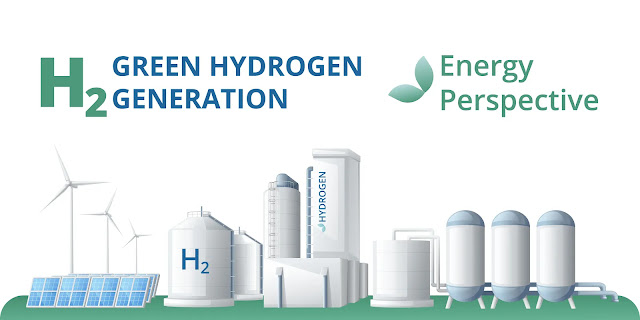First, we will talk a little about hydrogen and its types, and then we will talk about Japan's problem with investing in hydrogen.
What is hydrogen?
Hydrogen is a colorless, odorless, non-toxic gas with a density about 14 times less than that of air. It is also the lightest, simplest, and most abundant chemical element in nature; It is estimated that it constitutes about 75% of the total volume of the universe and that 90% of all atoms are hydrogen atoms, according to information seen by the Energy Research Unit.
The problem is that hydrogen does not exist freely in nature except in very rare cases. It is - mostly - associated with other molecules, whether with natural gas in its gaseous state or with water and oil in its liquid state; Therefore, obtaining it requires separating it from other elements.
The discovery of hydrogen dates back to 1671 by the British scientist, Robert Boyle, when he found that placing a piece of metal inside an acid leads to a reaction and results in gas bubbles. Boyle recorded these observations more than 350 years ago without defining the cause of these bubbles or the type of gas. The result, however, was completed by the British scientist, Henry Cavendish, after nearly 100 years, specifically in 1766.
Cavendish followed the same reaction, but this time collecting bubbles from the corrosion of a piece of metal in acid and using them for ignition. The result was the condensation of water vapor; At the time, it was called "hydrogen", and its definition: was that it is a substance that, as a result of work, causes the formation of water vapor, and this definition was according to laboratory experiments more than 350 years ago.
What are its types?
Japan's problem with investing in hydrogen
According to the Renewable Energy Institute (REI), the push to use hydrogen in some sectors has done more harm than good.
Japan is a leading country in adopting modern innovations and technology, and it has worked for decades to adopt renewable energy sources as an alternative to fossil fuels in order to preserve the environment. Even the Japanese company Toyota seeks to build entire cities that depend on hydrogen as a main source of energy.
But a new report issued by a Japanese institute said that Japan was investing in hydrogen in the wrong way and that its efforts to get rid of carbon were not successful.
What is Japan's problem with using hydrogen?
During the past decades, with increasing awareness and interest in the negative effects of fossil fuels on the environment and climate change, researchers and scientists began working on developing ways to reduce carbon emissions in the atmosphere and put forward many applicable ideas.
One of these ideas was to rely on hydrogen, as it is a combustible gas and only water vapor results from its combustion, and it can be obtained by electrolyzing water. Japan wanted to become a leading country in the production of hydrogen fuel, because it is a country that lacks energy resources and imports them from abroad, meaning that the issue of energy in Japan is a matter of national security.
So, in 2017, Japan became the first country in the world to adopt a comprehensive national hydrogen plan, and Japanese companies like Toyota pledged to build hydrogen-supported cities.
To implement this plan, the Japanese government has pumped a lot of money into investing in hydrogen energy. For example, in 2021 alone, the government spent about $800 million on hydrogen-related projects.
Renewable hydrogen
The rush to use hydrogen in some industries, however, has, in the opinion of the Renewable Energy Institute (REI), one of Japan's most well-known environmental think tanks, done more harm than good.
The hydrogen strategy promotes the use of gray hydrogen, which has a minimal impact on reducing carbon emissions, according to the institute's analysis.
What is meant by the gray hydrogen mentioned in the report is the most produced type of hydrogen in the world, which is produced by electricity generated by burning methane gas, which is considered one of the most greenhouse gases.
Green hydrogen
The estimate argues that relying on hydrogen as a significant energy source alternative to fossil fuels in all sectors is very difficult, given that we are currently unable to produce green hydrogen in large quantities, and green hydrogen is hydrogen produced from water decomposition using electricity generated from renewable energy sources such as solar energy—or wind power.
The report adds that Japan's strategy to rely on hydrogen has made many sectors believe that they should rely on electricity as a main energy source instead of fossil fuels and that hydrogen should only be used in sectors where it is difficult to remove carbon.
This is because most of the government's investments in the national hydrogen strategy have gone to specific sectors only, such as the development of fuel stations and hydrogen cars.
Hydrogen as clean energy
According to the estimate, this unbalanced investment in the hydrogen sectors caused great harm, as many sectors that did not receive support for the use of hydrogen thought that it did not cause much environmental damage, and therefore continued to rely on electric energy generated by burning fossil fuels.
Even the national hydrogen strategy in Japan made companies and individuals believe that the state is responsible for carbon removal, and thus decreased investments in renewable energy sources such as solar energy, as the report confirms that Japan lagged far behind European countries in establishing solar energy infrastructure.
The nearly 20-page report concludes that a complete hydrogen-based society in Japan is still a long way off and that Japan's national hydrogen strategy has completely backfired and should be reconsidered and other clean energy sources supported more.



Comments
Post a Comment